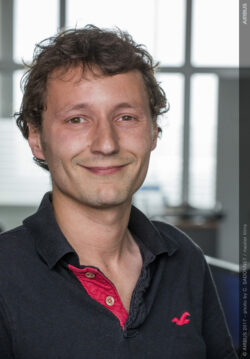- Eleni Chatzi, ETH Zurich: Structural dynamics as a principal pillar to AI-enhanced digital twinning
- Spilios Fassois, University of Patras: Time series based robust damage and fault diagnosis for structures and systems under uncertainty
- Fabien Ayme, Airbus: Operational Modal Analysis in aeronautical industry – some examples at Airbus
- Frédéric Batlle, Safran: Dynamic computational model and health monitoring of gas turbines for helicopters
Keynote: Structural dynamics as a principal pillar to AI-enhanced digital twinning
 | Eleni Chatzi is a Full Professor and Chair of Structural Mechanics and Monitoring at the Institute of Structural Engineering of the Department of Civil, Environmental and Geomatic Engineering of ETH Zürich. She currently serves as the President of the European Academy of Wind Energy (EAWE). Her research interests include the fields of Structural Health Monitoring (SHM), hybrid modelling for digital twinning, and data-driven decision support for engineered systems. She is an author of over 350 papers in peer-reviewed journals and conference proceedings, and further serves as an editor for several international journals in the domains of Dynamics and SHM. She led the recently completed ERC Starting Grant WINDMIL on the topic of “Smart Monitoring, Inspection and Life-Cycle Assessment of Wind Turbines”. Her work in the domain of self-aware infrastructure was recognized with the 2020 Walter L. Huber Research prize, awarded by the American Society of Civil Engineers (ASCE). She is further recipient of the 2020 EASD Junior Research Prize in the area of Computational Structural Dynamics, the JM Ko Award and the 2024 SHM Person of the Year award. Abstract: This talk will offer a view to the role of dynamics, often characterised by structured inference schemes, such as Modal Analysis, as a cornerstone to advancing AI-enhanced Digital Twins. Given the highly individual nature of structural assets, dynamical signatures can offer foundational insights into the behavior of complex infrastructures, which operate under highly fluctuating real-world conditions. This talk explores the integration of Structural Health Monitoring (SHM) with physics-enhanced machine learning (PEML), where domain-specific physical principles enrich machine learning models, increasing their robustness and predictive accuracy. Dynamics will be showcased as a main ingredient to such a goal, through i) fusion of related equations and properties into ML-based learning schemes, ii) use of formal grammars as vocabularies that admit dynamics principles as “rules” for model discovery, iii) graph architectures, which can infer dynamic interdependencies at system level, on the basis of simulation and monitoring information. The fusion of data-driven AI with physical laws paves the way for next-generation infrastructure management, where resilient, adaptive systems contribute to sustainable urban and industrial growth. |
Lecture of Honor: Time series based robust damage and fault diagnosis for structures and systems under uncertainty
 | Spilios Fassois is Professor and Director of the Stochastic Mechanical Systems and Automation SMSA Laboratory at the University of Patras, Greece. His research interests are on stochastic mechanical and aeronautical systems, statistical time series methods, data-based modeling, diagnostics, Structural Health Monitoring, and Machine Learning with applications on structural, vehicular, aeronautical, and other types of systems. He is the recipient of the 2023 Evangelos Papanoutsos Excellence in Teaching Award at the University of Patras, the 1990 Excellence in Teaching Award of the College of Engineering at the University of Michigan – Ann Arbor, and various other awards and distinctions. He is Editor-in-Chief for the Journal of Mechanical Systems and Signal Processing, Associate Editor and Editorial Board Member for various other international journals, and Scientific Committee member for numerous international conferences. He has given numerous invited presentations, has organized 4 Thematic Issues for esteemed international journals, and published over 320 articles in prestigious technical journals, conference proceedings, and technical encyclopedias. Abstract: The presentation focuses on statistical time series based damage and fault diagnosis for structures and engineering systems operating under uncertainty. The various versions of the problem formulation are reviewed, and a concise, yet critical, overview of the main principles, underlying assumptions, and available approaches is presented. The need for robustness, arising from the necessity for counteracting the effects of uncertain Environmental and Operational Conditions (EOCs), but also those associated with populations of similar structures and systems, is demonstrated. The main concepts and approaches of robust methods are then critically reviewed, with emphasis on conceptual and practical simplicity, ease of use, operation with a low number of sensors and limited numbers of training signals, physical interpretability, and the achievement of high-performance levels for even `minor’ fault levels. The novel and holistic Functional Model (FM) based method, within which the subproblems of damage/fault detection, precise localization, and level estimation may be seamlessly addressed, is subsequently introduced. Its various forms, including those based on measurable EOCs and recent ones capable of eliminating this requirement, are discussed. Application case studies, pertaining to damage diagnosis for engineering structures of various types and on-board fault diagnosis for railway suspension systems under uncertainty, are then presented, with diagnostic performance systematically assessed via Receiver Operating Characteristic curves and related metrics. The presentation concludes with remarks on current achievements, the technology’s status and limitations, and perspectives on the way forward. |
Industrial Keynote 1: Operational Modal Analysis in aeronautical industry – some examples at Airbus
 | Fabien Ayme has been working in the Airbus Commercial division’s Vibration Flight Test Department since 2013. Fabien has a Master’s degree in Mechanical Engineering with a specialization in Acoustics and Vibrations from École Centrale de Lyon (2009). In 2013, he received his PhD in Vibro-acoustics from the MEGA Doctoral school of Lyon. Between 2013 and 2016, he worked on various vibro-acoustic topics. Since 2016, he has been responsible for aero-elastic testing within the team, dealing with GVT, flight domain opening and flutter tests. He is currently completing an expert path to attain the role of aero-elastic testing expert. Abstract: During the test campaign of a new aircraft, several major tests rely on modal analysis capabilities. Many of these, such as the Ground Vibration Test (GVT) and Flutter tests, are closely tied to aeroelastic topics. Currently, the industry standard is to perform these tests using Experimental Modal Analysis (EMA), utilizing shaker forces or control surface deflections as input parameters. This keynote will first present the opportunities for using Operational Modal Analysis (OMA) at Airbus, particularly a fully automated method, in these well-established aeroelastic tests. The discussion will then focus on ongoing Airbus civil experimental and research projects where OMA could play a key role. These include its application in continuous flutter monitoring during flight, Structural Health Monitoring (SHM) for onboard equipment, shock monitoring and detection at the gate, and data hybridization from various measurement devices (accelerometers, optical fibers, high-speed cameras, etc.). Finally, key challenges and limitations will be addressed, such as automating the method for continuous monitoring, ensuring a thorough understanding of structural dynamics for accurate OMA analysis, uncertainties in damping estimation, robustness of the method, the absence of modal mass estimation, and computational time constraints. |
Industrial Keynote 2: Dynamic computational model and health monitoring of gas turbines for helicopters
 | Frédéric Batlle is a Senior Expert at Safran Group and a Technical Auditor at Safran Helicopter Engines, specializing in mechanics and vibrations. Since joining Safran in 1996, he has worked on turbomachinery vibrations, focusing on overall dynamics, rotor dynamics, equipment vibrations, and structural behavior. With expertise built through engine development, certification, production support, and fleet monitoring, he represents Safran’s knowledge to aircraft manufacturers and certification authorities. He also conducts internal and group-wide audits and serves as a trainer at Safran University, leading courses on dynamics, vibrations, and mechanical integration. Abstract: After a brief presentation of the Safran Group, the keynote will introduce the context around the gas turbine as the core business of Safran Helicopter Engines. The gas turbine is still the most widespread solution for powering helicopters. This propulsion system is basically made up of high-speed rotating assemblies, which generate complex vibration problems that need to be addressed during design and development. It is also important to bear in mind the high stakes involved in integrating the engine into the airframe of an aircraft. This keynote will therefore look in detail at how to characterise and validate the vibration and modal behaviour of an engine installed in a helicopter airframe. To do this, we will review the models used to model these dynamic behaviours during the design and development phases, as well as the tests required to validate these models. Once the engine has been certified by the authorities, it can be marketed and put in service with users. We will then look at the on-board monitoring systems used to monitor the engine’s vibration behaviour during operation. The means used to carry out vibration monitoring will be described, along with the dedicated objectives (trend control and monitoring, preventive maintenance). To conclude this keynote, a concrete case will be discussed to illustrate the importance of properly characterising, with the help of the aircraft manufacturer, the dynamic behaviour of an engine installed during the design phases and the risks, both technical and commercial, that an uncontrolled situation could represent. |
